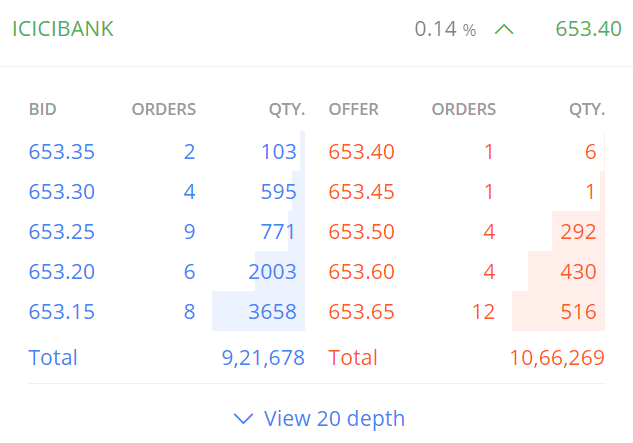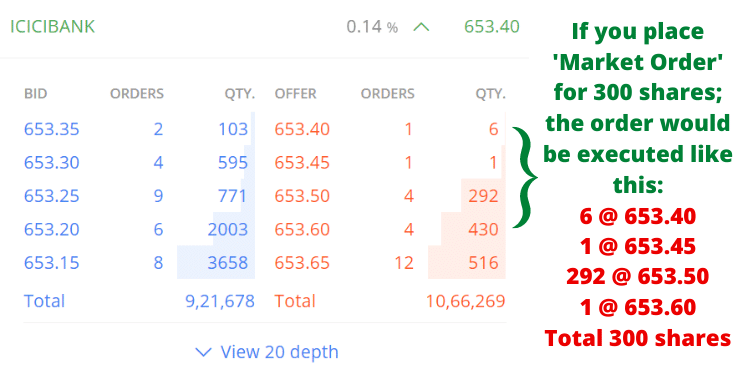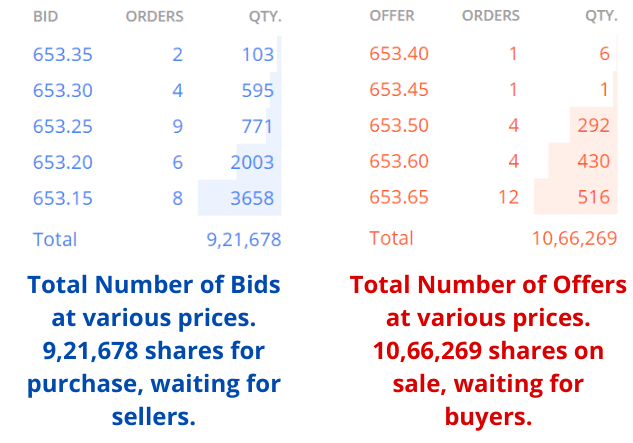Before you buy a stock from Zerodha, you can take a look at ‘Market Depth’ which shows you the latest ‘Bid and Offer’ orders.
So, what is bid and offer in Zerodha?
Bid is the highest price a ‘buyer’ is willing to pay for a share. Offer is the lowest price a ‘seller’ is willing to sell a share.
After you click on ‘Market Depth’, Zerodha will show 5 highest bids from buyers. And 5 offers from sellers.
Let us take an example of ICICI Bank share.

The above image is ‘Bid and Offer’ of ICICI Bank.
- 0.14% is the percentage rise in share price today.
- ₹ 653.40 is the LTP or ‘Last Traded Price’.
- Below that, Bid is on the left side and Offer is on the right.
Let us understand the ‘Bid and Offer’ numbers in more detail.
At the time when the image was captured, the highest price a buyer was willing to pay was ₹ 653.35. There were 2 orders at this price and the quantity they wanted to buy was 103 shares.
On the right side, the lowest price a seller was willing to sell shares of ICICI Bank was ₹ 653.40 – One person was selling 6 shares.
Now, let’s assume you want to buy 300 shares of ICICI Bank at any price. You would have to place a ‘Market order’.
As soon as you click ‘buy’, the following would happen:
- 6 shares would be purchased at ₹ 653.40
- 1 share would be purchased at ₹ 653.45
- 292 shares would be purchased at ₹ 653.50
- 1 share would be purchased at ₹ 653.60
- Total 300 share purchased at average of ₹ 653.498.

That is how an order gets executed.
The same would be applicable if a ‘sell’ order is placed. Let’s say someone wanted to sell 300 shares at any price. A ‘market order’ would be placed.
This is how it will be processed or executed:
- 103 shares would be sold at ₹ 653.35
- Remaining 197 shares would be sold at ₹ 653.30.
- Total 300 shares sold.
However, let us say you want to buy 500 shares at exactly the price of ₹ 653.20. You will have to place a ‘limit order’ and mention the price as ₹ 653.20.
The order would not get immediately executed. In the image above, there were buy orders for 2003 shares at ₹ 653.20. Your order would get added to this.
Since your order was for 500 shares, it will get added to the pending order of 2003. It will now show as 2503 quantity.
You would now have to wait for some seller to agree to sell the shares to you at ₹ 653.20. Until there is a seller for that price, your order would be pending.
After all higher price orders are executed, then your turn ‘could’ come. ‘Could’ because, if the price continues to rise and there are no sellers, your order will not get your shares.
That is the reason why – if a buyer wants shares immediately, ‘market order’ has to be placed. Same applies to immediate execution of sell order.
At the bottom of the image, there is the ‘Total’ row.

- The total number of shares buyers want to buy is 9,21,678.
- The total numbers of shares sellers want to sell is 10,66,269.
This number helps us understand if there are more buyers or sellers for a particular share. In the ICICI Bank example, there were more sellers than buyers.
Zerodha also gives you the option to expand this box and see ‘Top 20 Bid and Offer’ at different price points.
If you have any confusion related to ‘Bid and Offer’, please post your question in the comments section below. It would be our pleasure to answer any question. Thank you for reading.

How total number of seller and buyer data help in understanding price increasing or decreasing?